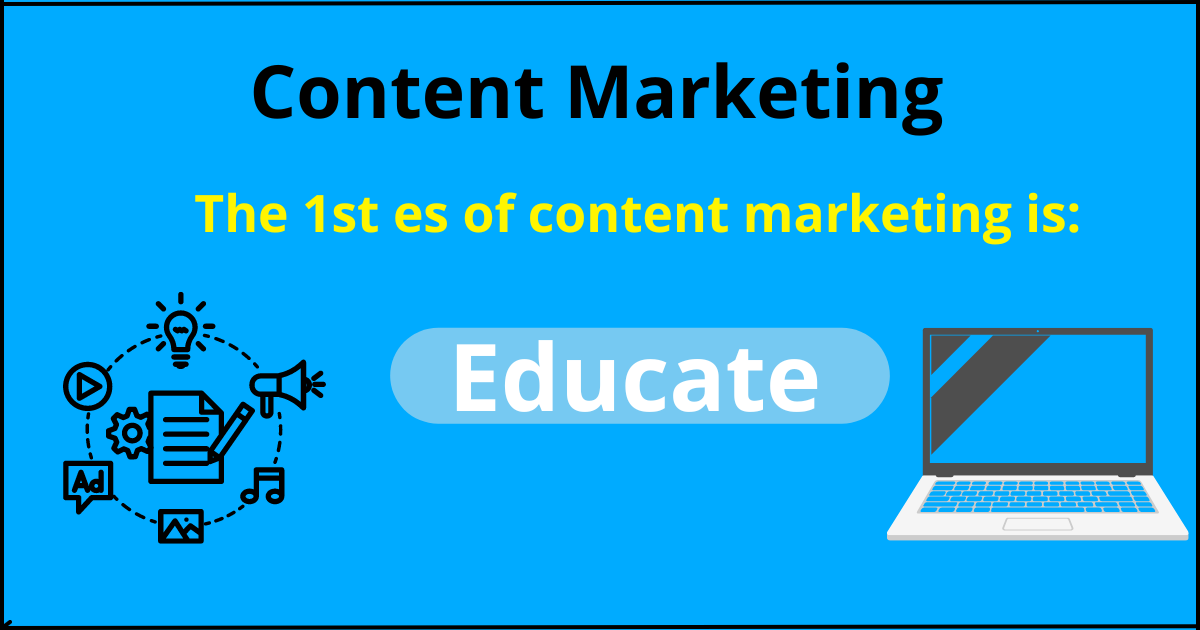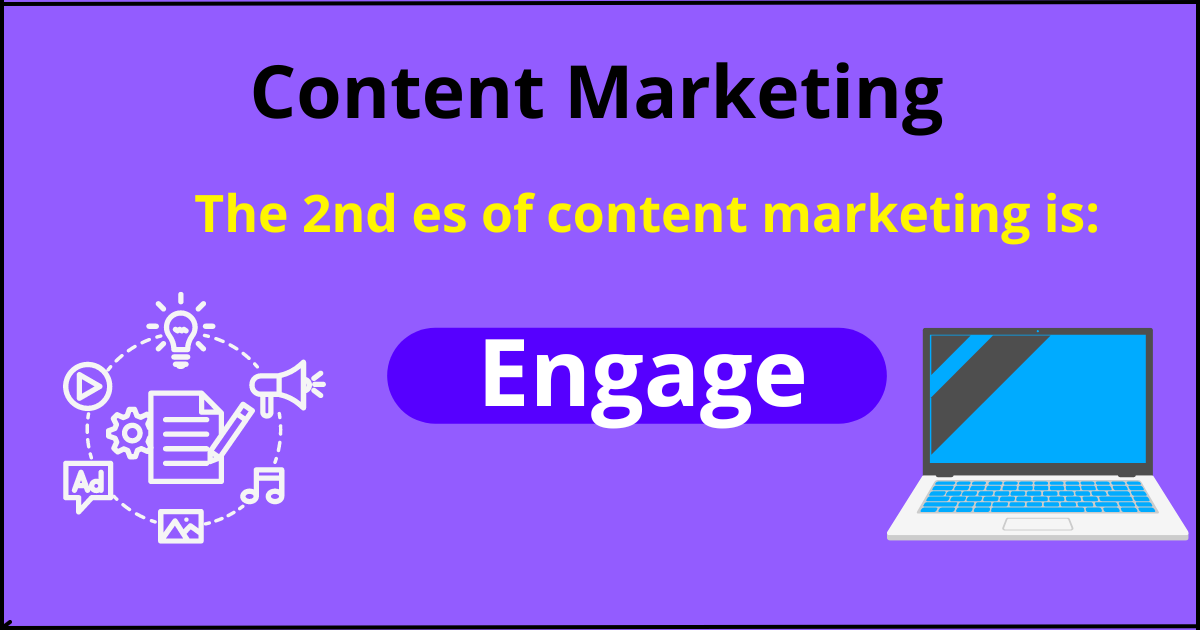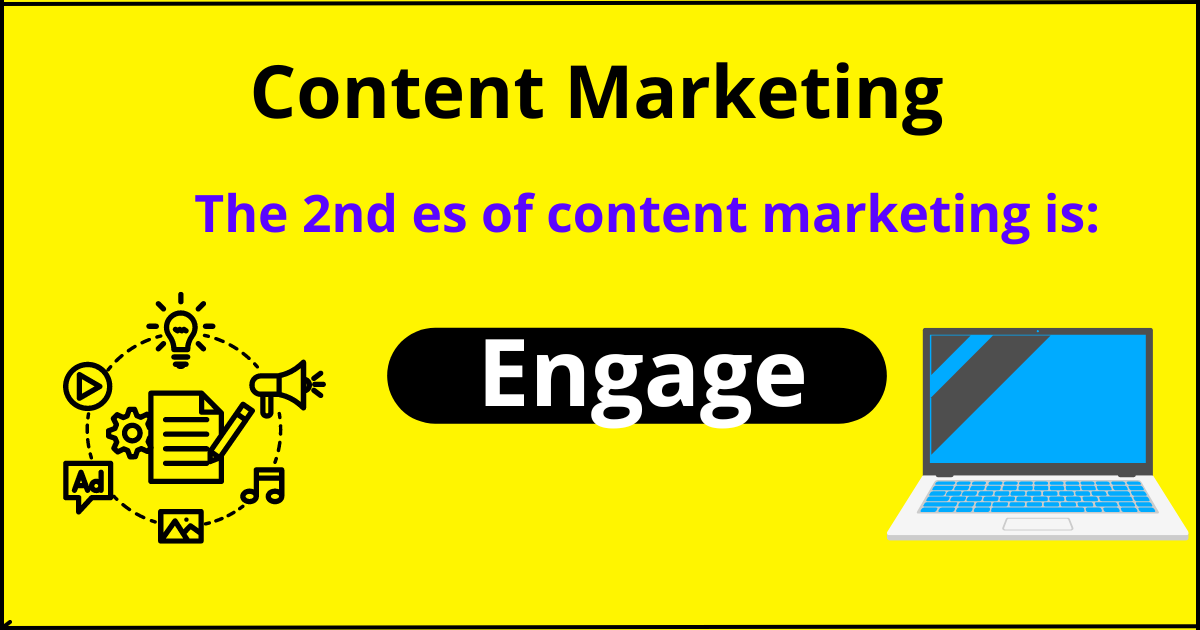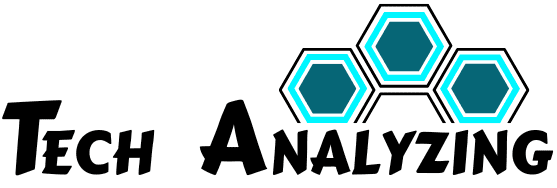Introduction:
The 3 es of content marketing is a way for businesses to tell people about their products, make friends with customers, and grow their business. To do this well, it’s essential to focus on the 3 es of content marketing: Educate, Engage, and Entertain. This guide will only explain each of these and give examples to help you use them in your content marketing.
The 3 es of content marketing:
Educate: Building Trust Through Knowledge:

Education is critical in content marketing. It means giving your audience helpful information that helps them solve problems, make good choices, and learn more about your industry. When you share educational content, your brand becomes known as an intelligent and trustworthy leader. This makes people trust you more. Here’s how you can use education in your content marketing strategy
Creating Valuable Educational Content:
- Articles and posts on blogs: Write blog posts and articles regularly to help your audience solve problems or answer common questions. Ensure these are well-informed and offer helpful guidance that individuals can follow up on. For example, a digital marketing agency might write detailed articles on SEO, plan content strategies, and share tips for social media marketing. This approach is vital to the 3 Es of content marketing—Educate.
- How-to Guides and Tutorials: Create detailed guides and step-by-step instructions that teach your audience how to use your products or services. These can be written guides, videos, or infographics. For example, a software company could create a series of video tutorials showing how to use its platform and all its features. This method fits perfectly with the 3 e’s of content marketing.
- E-books and Whitepapers: Provide detailed resources like e-books and whitepapers that explore industry topics deeply. These long pieces of content can help you get new contacts by offering them in exchange for contact information. For example, a financial services company might create a whitepaper on investment strategies using data and expert advice. This also fits into the 3 Es of content marketing educate.
Using Educational Content in B2B Marketing:
The 3 es of effective b2b content (business-to-business) marketing, sharing helpful information is essential. It helps people who make big decisions at companies understand things better. Here are some strategies:
Case Studies: Real-Life Examples:
- Case studies are stories about how your product or service has helped other businesses. They show real results and can be very convincing.
- For example, Imagine you sell CRM software. You could write a case study about a business that used your software. You would explain how the software helped the company sell more and manage its customers better.
- These case studies fit into the “Educate” part of content marketing because they teach others how your product works and the good results it can bring.
Webinars and Workshops: Live Learning Events:
- Webinars and workshops are online events where experts discuss important topics and answer questions from the audience. They allow people to learn in real-time and ask questions.
- For example, If you run a cybersecurity company, you might host a webinar about new security threats and how to keep data safe.
- These events help educate people by giving them helpful information and tips, which fits into the “Educate” part of content marketing.
Online Courses and Certifications: Learning Online:
- Online courses and certifications are like special classes you can take online. They teach people essential skills and knowledge about your industry.
- For example, You could create online classes to teach people how to use your project management software effectively if you sell it.
- These classes help teach people new things, which fits into the “Educate” part of content marketing.
Measuring the Impact of Educational Content:
To see how well your educational content is working, you can check a few things:
- Engagement Metrics: Look at how long people stay on your page, how often they leave quickly, and how usually they share your content. This will help you determine whether they like what they see.
- Lead Generation: Count how many new people contact you or show interest after reading your e-books or whitepapers. This tells you if your content is attracting new customers.
- Feedback and Surveys: Ask people what they think about your content through surveys and comments. This will help you understand whether they find your information useful.
Engage: Creating Interactive and Involving Content:

Engagement is about making content that grabs your audience’s attention and makes them want to interact with your brand. When your content is engaging, it builds a sense of community and keeps people interested. Here’s how to increase the level of engagement in your content:
Crafting Interactive Content:
Quizzes and Surveys: Fun and Interactive:
- Quizzes and surveys are excellent tools for getting people to participate and share their thoughts. They can be fun and help you learn more about what people like or need.
- For example: Create a quiz to help people choose the best skincare products if you own a skincare brand.
- These devices assist individuals with reaching out and remaining intrigued, which is an extraordinary way to “Lock in” in satisfied showcasing.
Interactive Infographics: Fun Ways to Explore Information:
- Interactive infographics are exceptional graphics that let people click and explore information independently. They help make complicated data easy to understand and enjoyable.
- For example: A travel agency might create an interactive infographic where people can click on different travel spots to see incredible places and activities.
- These infographics make learning about information fun and keep people engaged, which fits into the “Engage” part of content marketing.
Interactive Tools and Calculators: Personalized and Fun:
- Interactive tools and calculators let people get particular recommendations based on what they input. They are engaging and give quick, helpful results.
- For example, an insurance company might create a calculator that helps people determine how much coverage they need by entering different details.
- These tools are engaging because they offer immediate and personalized help, fitting into the “Engage” part of content marketing.
Engaging Through Social Media:
Social Media Posts: Getting People to Interact:
- On social media, share posts that make people want to like, comment, and share. This can be news about your industry, expert opinions, or behind-the-scenes looks at your company.
- For example: A fashion brand might post photos of their customers wearing their clothes.
- These posts help people interact and stay interested, which fits into the “Engage” part of content marketing.
Live Streams and interactive Discussions:
- Real-Time Interaction Live streams and Q&A sessions are events where participants can directly interact with you during the event. They let you talk to your audience and respond to questions in real-time.
- For example, a tech company might host a live session in which it talks about its new product and responds to viewers’ questions.
- Events like these help people connect with you and keep them interested, which is part of content marketing’s “Engage” goal.
Giveaways and Contests: Fun Ways to Participate:
- Contests and giveaways are entertaining occasions where participants can participate and win prizes. They assist with making your image more noticeable and get individuals energized.
- For example, a food company may hold a contest in which participants submit their own recipes made with the company’s products.
- These activities reflect the “Engage” aspect of content marketing, which encourages participation and ongoing engagement.
Success in Engagement Metrics: Instructions to Check if Your Techniques Are Working:
To check whether your approaches to getting individuals included are working, you can check a couple of things out:
- Engagement on Social Media: On social media, look at how many likes, comments, shares, and overall reactions your posts are getting.
- Intuitive Substance Execution: Check out how people respond to the surveys and quizzes you’ve created.
- Growth of Audience: Determine the number of new community members, subscribers, or followers you gain from your engagement efforts.
Entertain: Making Content Tomfoolery and Significant:

In content marketing, entertainment means creating content that people will remember and enjoy. While educating and entertaining are necessary, adding entertainment can make your brand more relatable. How to include entertainment in your content is as follows:
Creating Humorous and Fun Content: Making Things Enjoyable:
Humorous Videos and Memes: Making Content Fun
- Create videos and memes that make people laugh and smile. Humour can make your content more relatable and easy to share.
- For example: A tech company could make funny videos about common tech problems and how they fix them.
- These funny and entertaining pieces help with the “Entertain” part of content marketing by bringing joy to your audience.
Brand Mascots and Characters: Fun Faces for Your Brand:
- Use mascots or characters to represent your brand in a fun way. These characters can be part of videos, social media posts, and other content.
- For example: A food brand might create a friendly mascot that shows up in animated videos and advertisements.
- These fun characters help make your brand more enjoyable and memorable, which fits into the “Entertain” part of content marketing.
Entertainment-Based Campaigns: Fun and Interactive Events:
- Create campaigns that include fun activities like games or themed events.
- For example: A sports brand might start a fantasy league where fans can play, win prizes, and join interactive features.
- These entertainment-based campaigns make your content exciting and engaging, fitting into the “Entertain” part of content marketing.
Telling Compelling Stories:
Brand Stories: Connecting Through Your Journey:
- Share tales about your image’s process, values, and mission. These stories help people feel connected to your brand.
- For example, a non-profit might tell stories about the people it has helped and the positive changes it has made.
- These brand stories make your content more engaging and memorable, fitting into the “Entertain” part of content marketing.
Customer Stories and Testimonials: Sharing Real Experiences:
- Showcase stories and testimonials from your customers to highlight how your brand has helped them. These real stories can be both entertaining and convincing.
- For example: A travel company might share travel diaries from happy customers about their great experiences.
- These customer stories make your content more engaging and fit into the “Entertain” part of content marketing.
Behind-the-Scenes Content: Showing the Inside of Your Company:
- Give people a look behind the scenes at your company. Share videos or photos of your team, how you work, and your workplace culture. This helps make your brand seem more personal and relatable.
- For example: A creative agency might share videos of their brainstorming sessions and what happens in their office.
- This behind-the-scenes content makes your brand more engaging and fits into the “Entertain” part of content marketing.
Measuring the Effectiveness of Entertaining Content: Checking How Well It Works:
To see if your fun content is working, look at these things:
- Audience Feedback: Collect comments and opinions from people about your entertaining content to see if they like it.
- Social Shares: Count how often people share your content and how far it spreads to see if it’s catching on.
- Brand Perception: Watch how people feel about your brand and if their opinions change because of your fun content.
Read more interesting information: What Is Digital Marketing Agency Digitechnoolabs.xyz
Bringing Together the Three Es in Your Content Plan:
To make a great content plan, mix the three es Educate, Engage, and Entertain—into everything you do. Here’s how:
Content Planning and Strategy:
- Create a content calendar: Plan to include a variety of posts, such as educational guides, entertaining quizzes, and videos. This will keep people interested and ensure that your content is valuable.
- Clear Objectives: Set an objective for your content, such as expanding the number of individuals who are familiar with your image, procuring new clients, or getting more likes and shares. Ensure that your content helps you achieve these objectives.
Creation of Content: Making Incredible Substance with Various Techniques:
- Work with Specialists: Work with notable specialists and powerhouses to make your substance more dependable and intriguing. A financial institution, for instance, might collaborate with a well-known economist to produce a webinar on market trends. You can “Educate” and “Engage” your audience with this.
- Utilize a Selection of Formats: Create various content like blog entries, recordings, infographics, and webcasts. This way, you’ll be able to reach more people who enjoy different kinds of content. A health brand might offer helpful guides, video workouts, and blog posts. By using this, you can “Educate,” “Engage,” and “Entertain” your audience.
Content Distribution: Getting Your Content Out There:
- Use Different Platforms: Share your content on various places, like your website, social media, emails, and forums. Customize your content for each platform. For example, utilize short and tomfoolery posts for online entertainment, point-by-point articles for your blog, and inside-and-out reports for email bulletins. This helps educate, engage, and entertain, or the 3 e’s of marketing.
- SEO optimization: Ensure your substance is simple for web search tools to find. Use relevant words, create good meta descriptions, and follow SEO best practices. For example, a tech company could use keywords about new technologies in their blog posts. This helps with “Educate.”
- Engage with Your Audience: Talk to your audience on social media and other platforms. Reply to comments, join discussions, and share their content. For example, a fashion brand might share photos and customer reviews. This helps with “Engage.”
Measuring Success and Adjusting Strategies: Checking and Improving Your Content:
- Track Key Metrics: Use tools to check important numbers like the number of people visiting your website, their engagement, and how many leads or customers you get. For example, see how many people read your educational blog posts and whether they become customers. This helps with “Educate.”
- Analyze Content Performance: Find out which types of content (like educational, engaging, or entertaining) work best and which platforms bring in the most traffic. This helps you understand what your audience likes and where to put your effort. This covers all three es Educate, Engage, and Entertain.
- Get feedback from the audience: Ask your crowd for their perspectives through studies, remarks, or direct visits. Use their feedback to enhance and fill in any content gaps. For instance, more tests and surveys could be added if they need more intuitive content. This helps with “Engage.”
- Change Methodologies In Light of Experiences: Improve your content strategy by using the data you get from feedback and tracking. This could mean creating difficult new kinds of content, refreshing your substance plan, or utilizing various ways of sharing your substance. This keeps all the 3 es of content marketing-educate, Engage, and Entertain—working well.
Examples of Using the 3 es of Content Marketing:
- Educate: HubSpot is a great resource for learning about marketing. Its blog features supportive articles, guides, and online classes on topics like utilizing showcasing instruments and generating more leads. The company also offers free e-books and templates. This helps businesses learn and improve their marketing, which is a perfect example of “Educate.”
- Engage: Red Bull does a fantastic job at keeping people interested. They share exciting videos of extreme sports, fun challenges, and posts from their fans. Their website and social media have stories about athletes and adventures that get their audience involved. This shows how to “Engage” with people.
- Entertain: Old Spice is known for its funny and memorable ads. Their campaign with “The Man Your Man Could Smell Like” is an excellent example of using humour to catch people’s attention and make them remember the brand. This is a beautiful example of how to “Entertain” with your content.
Making a Great Content Plan with the Three Es:
To create a successful content plan, you must include all three Es—Educate, Engage, and Entertain. Here’s how to do it:
- Know Your Audience: Find out what your audience needs and likes. Please do some research to understand their problems and interests. This will help you make content that they find helpful and exciting. This covers all three Es—Educate, Engage, and Entertain.
- Mix Your Content: Plan to include different types of content, such as educational, engaging, and entertaining. Make sure each type helps you reach your marketing goals and serves a purpose. This keeps all three E’s working together.
- Make Great Content: Focus on creating useful, interesting, and fun content. Spend time on writing, design, and production to ensure your content stands out and is valuable. This approach fits the three E’s—educate, Engage, and Entertain.
- Share and Promote: Use different ways to share your content, like social media, emails, and ads. This helps you reach more people and make a more significant impact. This supports the 3 Es of content marketing.
Conclusion:
The 3 Es of content marketing—Educate, Engage, and Entertain—can help you connect better with your audience and reach your business goals. You can create a solid and effective content plan by making content that teaches, gets people involved, and is fun to watch
Remember, content marketing is constantly changing. Keep up with what your audience wants, evaluate the efficacy of your strategies, and strive to produce helpful content. Concentrating on the three Es can improve your audience relationships, achieve outstanding outcomes, and establish your brand as a market leader.
FAQs about the 3 es of content marketing:
1. What are the 3 Es of content marketing?
Educate: Teach your audience new things and help them understand your topic.
Engage: Make content that grabs people’s attention and gets them to interact with it.
Entertain: Make content fun and memorable so people enjoy it.
2. How can I create educational content?
Write blog posts or articles that answer common questions or give helpful tips.
Create how-to guides or tutorials that show step-by-step instructions on how to do something.
Offer e-books or special reports that go deep into a topic.
3. What are some examples of engaging content?
Quizzes and surveys: Fun questions that let people share their opinions.
Interactive infographics: Pictures that people can click on to learn more in a fun way.
Social media posts: Updates that make people like, comment, and share, as well as behind-the-scenes photos or expert opinions.
4. How can I make my content entertaining?
Create funny videos and memes that make people laugh.
Use mascots or characters that represent your brand in a fun way.
Run contests and giveaways to get people excited and involved.
5. Why is using all three Es in content marketing necessary?
Educates: Teaches your audience and builds trust.
Engages: Gets people to interact and stay interested.
Entertains: Makes your brand memorable and fun.
6. How do I determine my content’s success?
How long do people stay on your page, and how much do they share it?
Seeing how many new people contact you or show interest after reading your content.
Asking people what they think about your content through surveys or comments.
7. How can my strategy balance educational, engaging, and entertaining content?
8. What tools can help with creating and managing content?
Content management systems (CMS) like WordPress are used to publish and organize content.
Graphic design tools like Canva for making visuals.
Analytics tools like Google Analytics to see how your content is performing.
